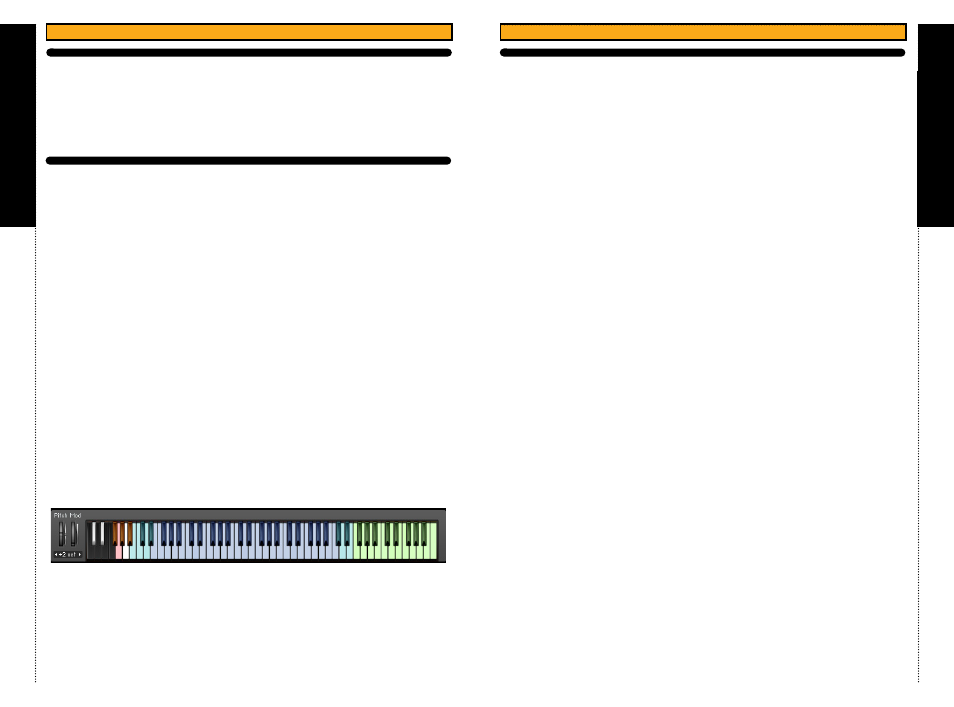Acou 6 tics / quick start – Vir2 Instruments Acou6tics Manual User Manual
Page 36

a
c
ou6tics
65
c
HAP
tER 21
/ QUICK S
TAR
T
cHAPtER 21
cHAPtER 21
AcoU6tIcS qUIcK StARt
66
c
HAP
tER 21
/
QUICK
S
TAR
T
Acou
6
tics/
QUICK START
AcoUStIcS qUIcK StARt
To begin, load desired instrument patch into Kontakt. By default, your
instrument is set to Bank 1 which is the Sustain Polyphonic Articulation.
When you press down a key on your keyboard in the blue playable range, a
sustain note is then triggered. To play a chord, simply play a chord as you
would on a piano in the blue play range and Acou6tics’ advanced chord
detection engine will automatically re-voice the chord as it would be played
on a guitar.
To simplify as much as possible how this instrument is played, one must
understand the layout of the instrument on your MIDI keyboard. The range
of the playable notes for the selected instrument are colored blue on the
virtual keyboard shown at the bottom of the Kontakt Player. The keys to the
left of the instrument range are Keyswitches (black/white) and Forced
Keyswitches (red), where as the keys to the right are Trigger Keys (green).
The cyan colored keys trigger no sound, however, will activate if played with
a chord.
The image bellow is the layout for Western (finger).
UNDERStANDING KEYSWItcHES
Keyswitches control the major articulations. As mentioned before, by
default, the instrument will load the sustain articulation (Bank 1) which on
the keyboard is C0. Pressing C#0 will switch to Bank 2, which is a bank that
includes a reduced sustain range and harmonics. D0 will switch to Bank 3,
which also has a reduced range for sustain which gives you the ability to
control individual strings of whatever chord you play within the instrument
range. D#0 is Bank 3 which switches play mode to tremolo. Banks 4 and 5
control Legato Mode with Bank 4 (E0) being legato focusing on hammer-on
and pull-off transitions, and Bank 5 (F0) focusing on Slide Up and Slide
Down transitions.
UNDERStANDING KEYSWItcH foRcED
A forced keyswitch is an articulation that is only initiated if the keyswitch is
held down on the keyboard. For instance, if you want to perform a
hammer-on at any given time, simply hold down F#0 while you play the
desired note.
Note: Forced keyswitches change depending on which bank is selected.
UNDERStANDING tRIGGER KEYS
Trigger Keys trigger a desired sound or strum. Trigger Keys will change
depending on which bank is selected.
Playing tip:
Many MIDI guitar products lose their realism when chords are
changed in a strum pattern. Due to this issue we developed a couple unique
trigger keys to achieve the most realistic transitions between two chords. It
is natural for a guitar player to lift all his fingers off the frets when switching
between chords resulting in the sound of the resonating open strings right
before the next chord is played. Use the Open Strings + Slide Noise trigger
key at D6 or D#6 to achieve this effect. Additionally, when a guitarist is
strumming a quicker and busier strum pattern often it is natural for an Open
Strum to occur because the player has already lifted his fingers to prepare
for the next chord on his final up strum. Use the Open String | Strum | Up
trigger key at C#6 to achieve this effect.
